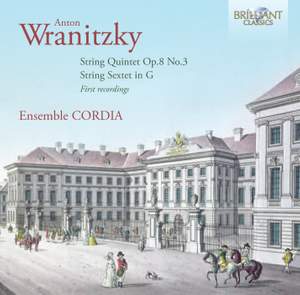Anton Wranitzky (1761-1820), a near-contemporary of Beethoven, was a leading figure in Vienna’s highest musical circles. He was under the patronage of Prince Lobkowitz and in that capacity he led the world premieres of Beethoven’s 3rd and 6th symphonies. Beethoven held him in high esteem as a composer.
Wranitzky’s skills and originality are shown in these two works for string ensemble. The Quintet in the unusual combination of 1 violin, 2 violas and 2 cellos, create fascinating deep sonorities from the ensemble. Ensemble Cordia present these beautiful Works for the first time on CD, played on original instruments by leading specialists in the Early Music field. The ensemble already won high critical acclaim for their earlier recordings for Brilliant (Telemann, Baroque arias and others). Although Anton Wranitzky (1761–1820) may not be a household name to listeners today, this skilled composer was one of the central figures of Viennese musical life at the turn of the 18th century. Like his teacher Haydn, he was a recipient of Prince Franz Joseph Maximilian Lobkowitz’s patronage and support.
As Kapellmeister and composer for the prince’s court ensemble,Wranitzky was at the forefront of Vienna’s musical culture, and it was in this position that he led the first private performances of Beethoven’s ‘Eroica’ and ‘Pastoral’ symphonies, among others. Later in his career he became orchestral director of the main theatres in Vienna, although the patronage that he had relied on dwindled later in his career, as Lobkowitz and other supporters experienced financial difficulties. Wranitzky’s chamber music reveals a voice of some individuality.The two works on this disc are scored for fascinating but rather unusual combinations of instruments, possibly in response to the musicians employed at the prince’s court: the Quintet in E flat features the grouping of one violin, two violas and two cellos, and the Sextet in G is scored for two each of violins, violas and cellos. In both works, the unusual sonorities that these combinations create are explored imaginatively, while Wranitzky’s approach to texture, theme and structure shows him to have been a composer of great skill and originality.





